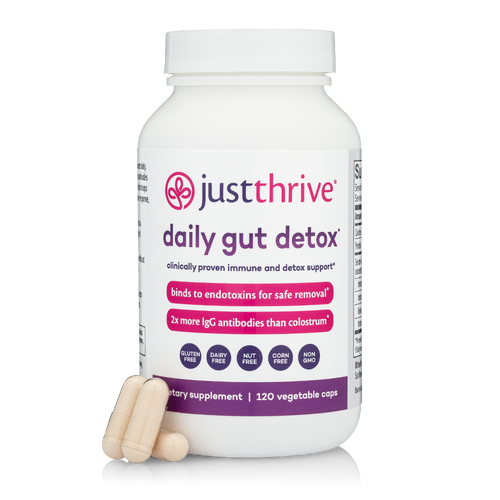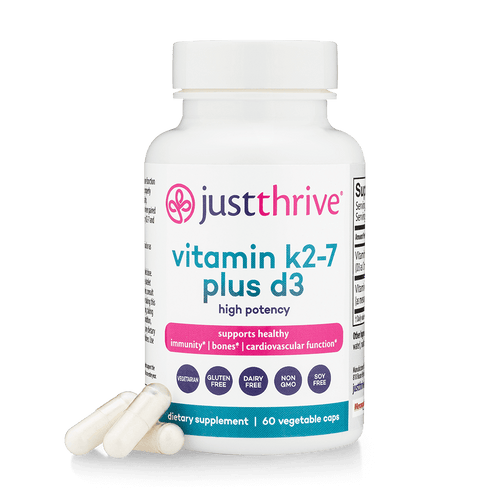Learn how to detox your home and your body the right way
Every spring we get that drive to deep clean our homes—a tradition that goes back to ancient times through almost every culture. We rid our living spaces of grime and clutter, polishing surfaces to a shine, and getting rid of winter soot and dust. We want to make everything fresh and clean and new as we detoxify our homes.
But that can work against us when the cleaning products we use contain toxins themselves. And it can be tough to find commercial cleaning products that are toxin-free.
So sweeping out environmental and household toxins this spring will take an extra step this year.
Knowing what to avoid… what to look for… and how to detox your home and your body will transform your spring cleaning this year and beyond.
Your Home Contains Environmental Toxins
Every day pesticides, mold, and dirt get tracked into your home. When you open the door, airborne toxins sneak in. And with the windows sealed tight over the winter, it’s easy to see how your home-based toxic load can become overwhelming. That’s one reason spring cleaning is a time-honored activity: To get rid of the winter build-up.

There’s a virtual alphabet soup of toxins found in practically every home from dozens of sources:
- VOCs – volatile organic compounds, chemicals that transform into inhalable gases, that include formaldehyde and benzene. Found in products like paint and paint thinners, permanent markers, upholstered furniture, and composite wood furniture.[1]
- PFAS – perfluoroalkyl/polyfluoroalkyl substances, forever chemicals that accumulate in the environment and the body. Found in many products, especially anything stain-resistant, water-resistant, or nonstick.[2]
- EDCs – endocrine disrupting chemicals, which interfere with healthy hormone production leading to disease. These include compounds like BPA (bisphenol A), phthalates, and triclosan. EDCs are commonly found in plastic containers, adhesives, and pesticides.[3]
Spring is the perfect time to rid your home of toxin build up and clear out mold and dirt that made their way into your home over the winter.
But it matters which tools you use to spring clean. Because, unfortunately, many cleaning products contain toxins themselves.

Household Cleaners Come with Toxic Ingredients
Getting rid of dirt, grime, mold, mildew, and winter build-up can call for some tough cleaners. But it’s important to make sure your cleaners aren’t bringing even more toxins into your home. And many cleaning products you’ll find on the store shelves are laden with toxic chemicals.
Whether you breathe in their fumes or absorb them through your skin, these chemicals add to your body’s toxic burden. That can make you feel sick and tired, along with harming your long-term health.
You can avoid toxic cleaning supplies by being on the alert for some specific ingredients. Start by paying attention to labels that use words like “danger” or “warning.” Any product with an added fragrance—and you can usually smell them before even the bottles are even open—contains toxic chemicals.
Some of the worst offenders contain those forever chemicals (PFAS) that can accumulate over time. Products that typically contain PFAS include:
- glass cleaners
- fabric and upholstery treatments
- floor wax and wood polish
- aerosol-based cleaners
- air fresheners
- waterproofing or stain-repelling sprays
As for VOCs, they’re commonly found in laundry detergents, fabric softeners, dishwashing liquids, products containing bleach, and oven cleaners.
You can see how spring cleaning can easily turn into an overwhelming toxic burden for your body that can cause many long-lasting health problems. Unless you take steps now to minimize the toxins.
How Toxic Accumulation Affects Your Body
No matter where they come from, toxins can overwhelm your body and begin to accumulate. No matter where you live or work… no matter how healthy your diet is… no matter how hard you try to keep your surroundings free from toxins… you’re constantly bombarded by chemicals. Everything from artificial fragrances and dyes to microplastics to air pollution can cause harm to your cells and organs.
And as they build up, these toxins have been proven to damage your health in serious ways.[4,5,6] Everyday toxins have been linked with many severe and long-term health issues including:
- Obesity[7]
- Joint pain[8]
- Depression[9]
- Infertility[10]
- Miscarriage[10]
- Memory loss[11]
- Type 2 diabetes[12]
- Cardiovascular disease[13]
- Cancer[14]
That’s why it’s so important to lighten your toxic load and support your body’s natural detox processes.

The 3 Best Ways to Detoxify Your Home
Clearing your home of toxins can do wonders to lower your body’s toxic burden. Luckily, there are very simple things you can do to maximize home detox and minimize toxic exposure.
Taking these three steps can transform your home from a place of toxic overload to a natural oasis that fosters health and wellness.
1. Switch to Natural/Non-Toxic Cleaning Products
Switch to all-natural, chemical-free cleaning products to reduce your home’s toxic burden. You can create your own supplies using natural ingredients like baking soda, white vinegar, lemon juice, essential oils, and water. If you don’t have the time to DIY, you can find a list of safe, non-toxic cleaning products on the EWG (Environmental Working Group) website.
2. Use a HEPA Air Purifier
Invest in a high-quality air purifier to remove toxic particles from your home environment. These machines can significantly improve the air quality in your home, removing dust, pollen, and pet dander along with environmental toxins and pollutants. An air purifier equipped with a HEPA filter can clear out practically all particles as small as 0.3 microns – at least 99.97% of them. (We highly recommend AirDoctor, which has a UltraHEPA® Filter that captures 99.99% of ultra-fine airborne contaminants down to .003 microns—100x smaller than standard HEPA filters.)
3. Add Indoor Plants to Your Home
Plants purify your air by absorbing carbon dioxide and producing fresh oxygen. Plus, some plants also absorb chemical toxins like formaldehyde and ammonia from the air, eliminating at least some indoor pollution. While almost any plant will at least contribute to home detoxing, some of the best include:
- Boston fern
- Spider plant
- Bamboo plant
- English ivy
- Peace lily
Detoxing your home will do a lot to reduce your body’s toxic burden. But with all of the toxins present in our environment—most of which are unavoidable—your body could use some extra support to stay ahead of toxic overload.
How to Encourage Your Body’s Natural Detox Pathways
Your immune system uses a specialized team to recognize and neutralize toxins: immunoglobulins (also called antibodies). They stay on the lookout for toxins 24/7, tagging and neutralizing everything from pesticides to heavy metals to household chemicals.[15]
Immunoglobulin G (or IgG for short) cells make up over 80% of your total immunoglobulin fighting force… and are your first-line defenders against toxins. Once your IgG antibodies detect and identify a toxic invader, they tag it so your body can handle it even faster in the future. Then they neutralize the toxin for safe removal from your body.
But when ongoing exposure leaves you dealing with a toxin overload, your defense team may need extra support to keep working properly. Supplying additional IgG troops to your body is the best way to deliver that support, specifically supplemental serum-derived bovine immunoglobulins.
Clinically studied, serum-derived IgG works just like the antibodies your immune system produces naturally to protect you against threats[16,17], giving your immune system the extra support it needs to do its job—keeping you safe and healthy.
Support Your Body’s Anti-Toxin System with Ultimate IgG
Keep your natural defenses strong and healthy with a daily supply of clinically studied serum-derived bovine immunoglobulins found in Just Thrive Ultimate IgG.
Ultimate IgG is the most highly-concentrated IgG formula on the market (contains more antibodies than any other comparable product). In this powerful immune and detox supplement you get:
-
IgG - the most prevalent type of antibody, accounting for about 80% of your immune power
-
IgA - provides surveillance of the gut lining, the respiratory system, and other surface barriers
- IgM - races to engage the threat and keeps it in check until your IgG joins the fight
By supplying fresh immunoglobulins in every capsule, Ultimate IgG supports your immune system in the face of unavoidable everyday toxins to keep you feeling vital and healthy.
>> Give your immune system extra spring-cleaning support Just Thrive Ultimate IgG.
But if you’re feeling unsure about trying Ultimate IgG, we can help.
EVERY Just Thrive purchase is covered by our Bottom of the Bottle, 100% money back guarantee.
So you can try Ultimate IgG to see if it works for you… and we’re confident it will.
But if for any reason you don’t feel a difference, simply ask for a full product refund at any time. Even if it’s been 3 months or 3 years. Even if the bottle is empty!
Sources
- David E, Niculescu VC. Volatile Organic Compounds (VOCs) as Environmental Pollutants: Occurrence and Mitigation Using Nanomaterials. Int J Environ Res Public Health. 2021 Dec 13;18(24):13147.
- Pelch KE, Reade A, Kwiatkowski CF, Merced-Nieves FM, Cavalier H, Schultz K, Wolffe T, Varshavsky J. The PFAS-Tox Database: A systematic evidence map of health studies on 29 per- and polyfluoroalkyl substances. Environ Int. 2022 Sep;167:107408.
- Ho V, Pelland-St-Pierre L, Gravel S, Bouchard MF, Verner MA, Labrèche F. Endocrine disruptors: Challenges and future directions in epidemiologic research. Environ Res. 2022 Mar;204(Pt A):111969.
- Yilmaz B, Terekeci H, Sandal S, Kelestimur F. Endocrine disrupting chemicals: exposure, effects on human health, mechanism of action, models for testing and strategies for prevention. Rev Endocr Metab Disord. 2020 Mar;21(1):127-147.
- Fenton SE, Ducatman A, Boobis A, DeWitt JC, Lau C, Ng C, Smith JS, Roberts SM. Per- and Polyfluoroalkyl Substance Toxicity and Human Health Review: Current State of Knowledge and Strategies for Informing Future Research. Environ Toxicol Chem. 2021 Mar;40(3):606-630.
- Dewapriya P, et al. Per- and polyfluoroalkyl substances (PFAS) in consumer products: Current knowledge and research gaps. Journal of Hazardous Materials Letters. Volume 4, November 2023, 100086
- Veiga-Lopez A, Pu Y, Gingrich J, Padmanabhan V. Obesogenic Endocrine Disrupting Chemicals: Identifying Knowledge Gaps. Trends Endocrinol Metab. 2018 Sep;29(9):607-625.
- Lei T, Qian H, Yang J, Hu Y. The exposure to volatile organic chemicals associates positively with rheumatoid arthritis: a cross-sectional study from the NHANES program. Front Immunol. 2023 Jun 19;14:1098683.
- Tang L, Liu M, Tian J. Volatile organic compounds exposure associated with depression among U.S. adults: Results from NHANES 2011-2020. Chemosphere. 2024 Feb;349:140690.
- Yang, Q., Zhang, J. & Fan, Z. Association between volatile organic compounds exposure and infertility risk among American women aged 18–45 years from NHANES 2013–2020. Sci Rep 14, 30711 (2024). https://doi.org/10.1038/s41598-024-80277-6
- Gao C, Zhao X, Li T. Effects of indoor VOCs from paint on human brain activities during working memory tasks: An electroencephalogram study. Indoor Air. 2022 Jul;32(7):e13062.
- Wang X, He W, Wu X, Song X, Yang X, Zhang G, Niu P, Chen T. Exposure to volatile organic compounds is a risk factor for diabetes: A cross-sectional study. Chemosphere. 2023 Oct;338:139424.
- Nalini M, et al. Volatile organic compounds and mortality from ischemic heart disease: A case-cohort study. Am J Prev Cardiol. 2024 Jun 23;19:100700.
- Xiong, Y., Du, K. & Huang, Y. One-third of global population at cancer risk due to elevated volatile organic compounds levels. npj Clim Atmos Sci 7, 54 (2024).
- Janeway CA Jr, Travers P, Walport M, et al. Immunobiology: The Immune System in Health and Disease. 5th edition. New York: Garland Science; 2001. The distribution and functions of immunoglobulin isotypes. Available from: https://www.ncbi.nlm.nih.gov/books/NBK27162/
- Petschow BW, Burnett B, Shaw AL, Weaver EM, Klein GL. Serum-derived bovine immunoglobulin/protein isolate: postulated mechanism of action for management of enteropathy. Clin Exp Gastroenterol. 2014 May 24;7:181-90.
- Ulfman LH, Leusen JHW, Savelkoul HFJ, Warner JO, van Neerven RJJ. Effects of Bovine Immunoglobulins on Immune Function, Allergy, and Infection. Front Nutr. 2018 Jun 22;5:52.










